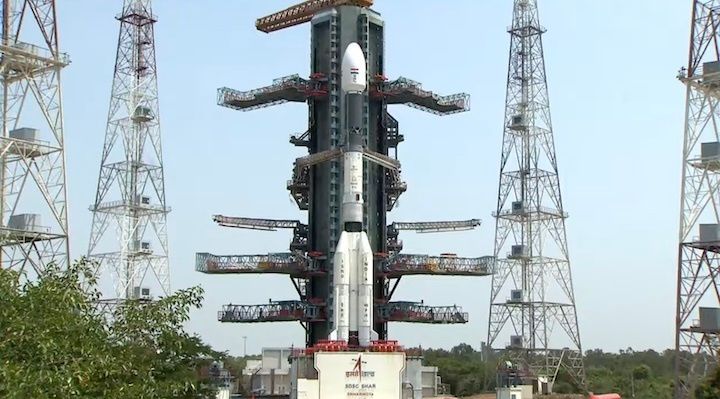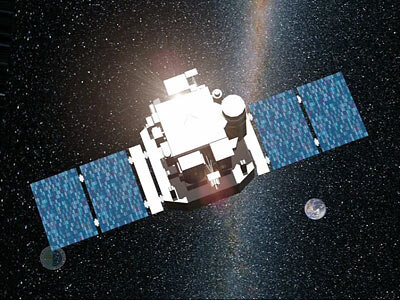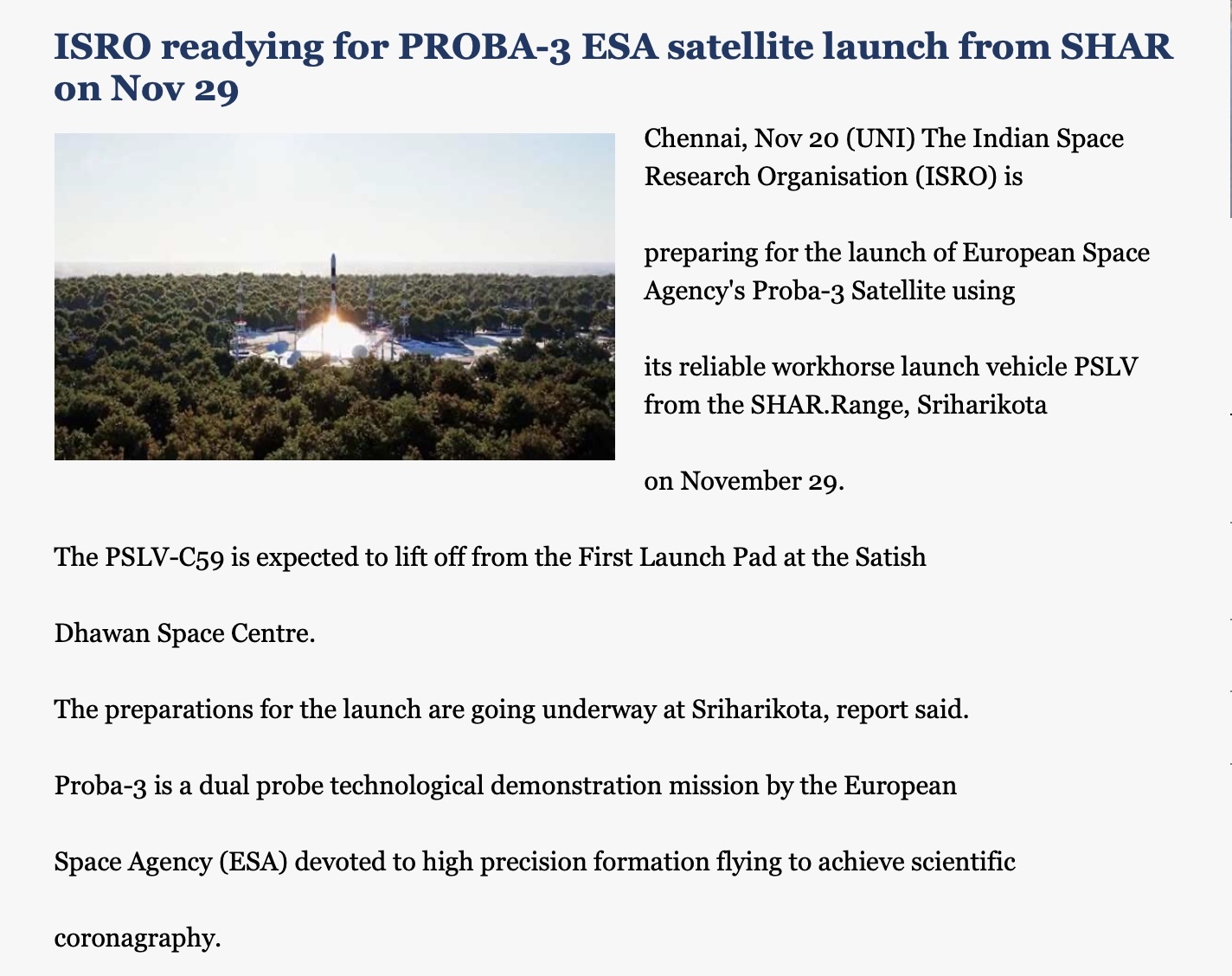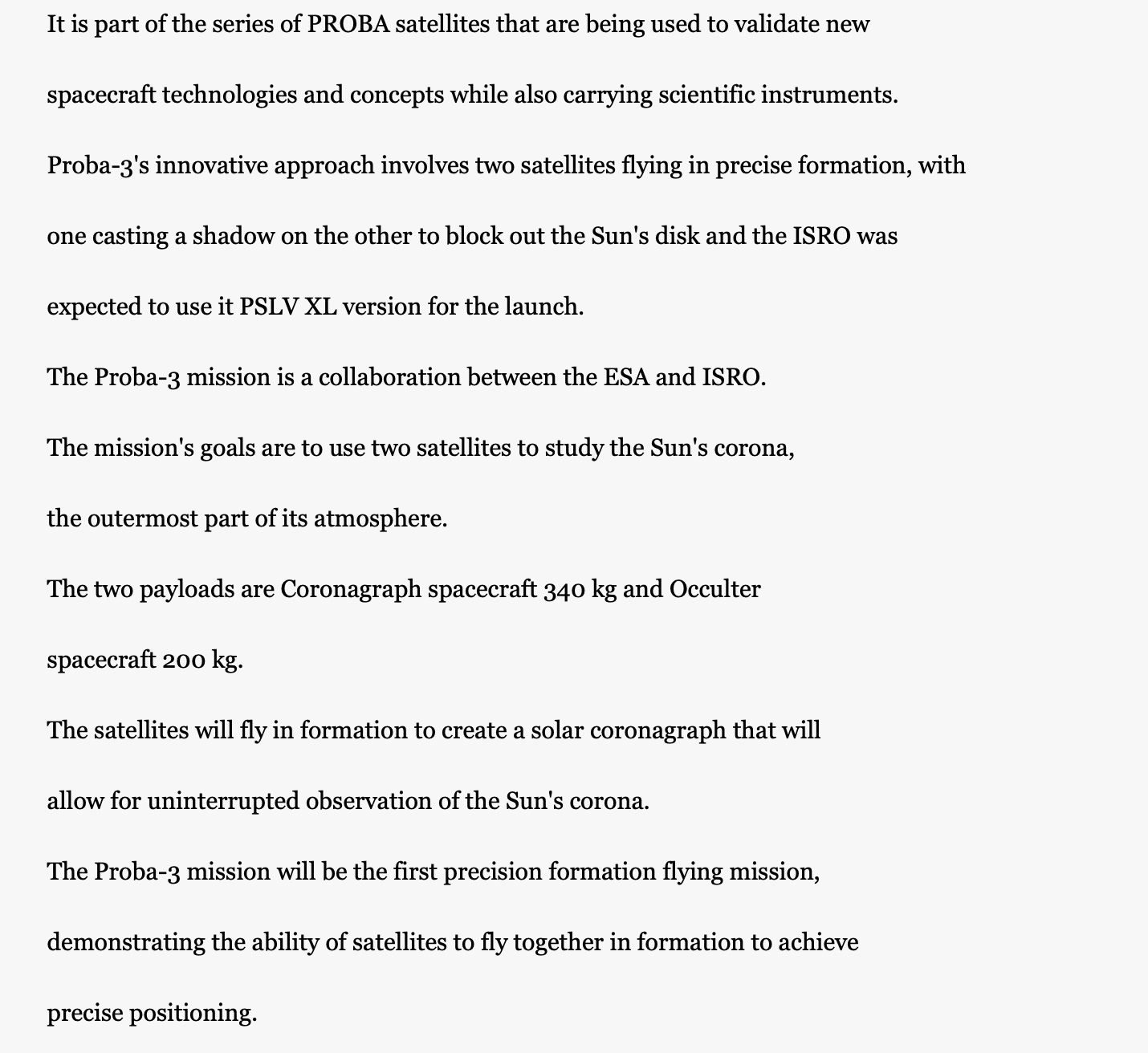7.11.2024
ISRO set to launch EU’s Proba 3 Sun observation mission in December: Minister
Union minister Jitendra Singh also set out the ambitious goal of establishing the Indian space station Bharatiya Antariksha Station (BAS) by 2035, and landing the first Indian on the Moon by 2040

New Delhi: The Indian Space Research Organisation (ISRO) is set to launch the European Union’s Proba 3 Sun Observation Mission in December, said Union minister of state (independent charge) for science & technology, Jitendra Singh, on Tuesday.
“The European Union’s large orbiter Proba 3, which will observe the Sun, will go to space from Sriharikota in December. Space scientists from ISRO and the European Union are going to jointly observe the Sun’s atmosphere,” Singh said speaking at the third Indian Space Conclave, organised by the Indian Space Association (ISPA).
The Proba-3 satellite, which arrived in Sriharikota this morning is designed to observe the Sun’s faint corona. This mission marks India’s third launch for the European Union, following support for the Proba-1 and Proba-2 satellites, but stands out due to its focus on solar observation. The satellite will be launched by the PSLV-XL rocket. Singh noted that Proba-3 will offer important data on solar corona dynamics, contributing to ISRO’s expanding scientific initiatives, which include the Chandrayaan-3 lunar mission. He also attributed the growth of India’s space sector to Prime Minister Narendra Modi’s policy changes.
Singh also set out the ambitious goal of establishing the Indian space station Bharatiya Antariksha Station (BAS) by 2035, and landing the first Indian on the Moon by 2040. He also added that India aims at increasing its contribution to the global space economy from 2% to 10%.
Singh also highlighted India’s growing capabilities in space innovation. “We are no longer waiting for technologies to be handed down to us; we are now innovators in our own right, developing solutions that are shaping global standards. The sense of confidence that permeates our space endeavors is a reflection of our commitment to excellence and our vision for a self-reliant India,” he said.
Isro chairman S Somanath also spoke at the conclave and said that India is working towards achieving “Atmanirbharta” or self-reliance in the space sector through enabling policies, large-scale investments, and strategic partnerships.
Somanath said, “With strategic partnerships and a united vision, we are poised to make India a leader in space innovation, ensuring a vibrant, self-reliant space sector for decades to come.”
“Under strong government leadership, we’ve moved from announcements to concrete projects, defining a future where space drives economic growth, national security, and technological innovation,” he added.
Somanath acknowledged the challenges faced in the upstream sector, particularly in building large platforms, rockets, and launching them. “The challenges in the upstream side, building big platforms, building rockets and launching them remain very elusive primarily because of the higher investment required, the technology risks, the possibility of failures, recovery,” he said.
While industries and startups are emerging, their ability to scale up and compete with established global players remains uncertain. Somanath pointed out that larger industry houses in India must play a key role in this effort. “India is not void of any big houses having enough capability to invest and create as much as others are there in the world. But they need to take the plunge, possibly alone or in a very cooperative mode with others where there are skills in various areas,” he added.
The Cabinet last month had approved a ₹1,000-crore venture capital (VC) fund, under the aegis of the Indian National Space Promotion and Authorisation Centre (IN-SPACE) for promotion of space oriented start-ups for the growth of space economy.
Somanath emphasised the need to foster leading space companies in India, not just service providers. “We need to create leading space companies in India, not just service providing companies. (We need to create space companies) who have the ability to design, conceive, manufacture and put up competitive, cost-competitive products in front of the world,” he said.
“With policies that enhance data accessibility, we’re enabling space- based applications to support sectors like agriculture and finance, aiming to create a robust, multifaceted space ecosystem,” Somanath said. He further said that India’s aim to landing an Indian on the moon by 2040 is the sign of India’s commitment to “human space exploration.”
Chairman of ISPA Jayant Patil outlined the economic impact of the space sector, noting that every rupee invested returns over 2.5 times to the economy, contributing over $60 billion to GDP in the past decade. “This sector is driving significant technological advancement and job creation. As we soar beyond the sky, we envision India’s space industry achieving exponential growth and contributing significantly by the 100th year of our independence,” Patil said.
Ambassador of the European Union to India and Bhutan Hervé Delphin said, “India and the EU are natural partners in space, both aiming for strategic autonomy in navigation, Earth observation, and communication technologies. With a shared vision for peaceful space use, we see immense potential for joint projects in climate monitoring, cybersecurity, and exploration.”
“Space diplomacy is crucial as well, and the EU seeks deeper collaboration with India through forums like the UN Committee on the Peaceful Uses of Outer Space, fostering responsible practices and preventing destabilising actions, such as anti-satellite tests,” Delphin said.
Quelle: Hindustan Times
----
Update: 8.11.2024
.
Proba-3 will constantly measure Sun’s energy output

Proba-3 is such an ambitious mission that it needs more than one single spacecraft to succeed. In order for Proba-3’s Coronagraph spacecraft observe the Sun’s faint surrounding atmosphere, its disk-bearing Occulter spacecraft must block out the fiery solar disk. This means Proba-3’s Occulter ends up facing the Sun continuously, making it a valuable platform for science in its own right.
The sunward side of the Occulter therefore hosts a dedicated instrument that will maintain a continuous measurement of the Sun’s total energy output, known as the total solar irradiance, which is a essential variable for climate studies.
The shoebox-sized Davos Absolute Radiometer, DARA, has been supplied to the mission by the Physical Meteorological Observatory Davos, PMOD, in Switzerland.

“Researchers used to talk about the ‘solar constant’ but in fact it is always changing slightly,” explains Wolfgang Finsterle, DARA Principal Investigator at PMOD. “And it’s essential to keep track of the total solar irradiance, because it is the dominant energy input to the surface of the Earth. It amounts to something like 99.978% of the energy available on Earth, including the conserved solar energy stored in coal and oil. It drives all the dynamic processes of Earth’s climate, so even the tiniest variations are hugely significant.”
The mountain-based PMOD has been studying total solar irradiance for more than a century, initially with ground-based instruments and then from the 1970s deploying space-based radiometers to acquire a continuous dataset. The World Meteorological Organization has mandated PMOD as the World Radiation Centre to calibrate radiation measurements across global UN monitoring programmes.

Wolfgang adds: “Total solar irradiance varies along with the 11-year cycle of solar activity, and one of the most obvious ways to look for long-term energy drift is to compare total solar irradiance between consecutive solar minimia.
“This requires a long time-series of data, ideally coming from multiple instruments because single radiometers will undergo degradation in sensitivity from the hard ultraviolet in the Sun’s rays they are continuously exposed to. That said any degradation is very gradual: the radiometer aboard the ESA-NASA SOHO solar observatory for instance, which was launched in back 1995, is still working satisfactorily.”

DARA’s basic operating principle is simple. The radiometer possesses a 5-mm diameter cavity made from black-painted silver, possessing low temperature emissivity. For 15 seconds at a time sunlight warms the interior of the cavity, then a shutter blade automatically closes at its entrance.
For the next 15 seconds electric heat maintains the cavity’s previous temperature – and the energy needed to maintain this temperature is extrapolated to the unit of total solar irradiance which is watts per metre squared.

This process continues for the entire lifetime of the instrument – the actuated shutter design employed in DARA has been tested for millions of opening and closings in PMOD’s vacuum chamber.
“DARA is an improvement on previous radiometer designs with an optimised cavity design to minimise unwanted straylight and a multi-channel measuring system for self-calibration,” adds Wolfgang. “This generation of instrument also possesses a fully digital control loop, allowing the possibility of experimenting with higher frequency observations.

Two versions of this radiometer design have already flown, notes Werner Schmutz of PMOD, who oversaw its development: “A compact version called CLARA flew on Noway’s NorSat-1 CubeSat in 2017, remaining operational to this day, while a previous DARA is serving aboard the Chinese FY-3E weather satellite, launched in 2021. So we have high confidence in the design, which can operate whenever the Proba-3 Occulter is pointed at the Sun within half a degree of accuracy.”
The main difference between Proba-3’s DARA and previous radiometers will be its very elongated orbit, which will carry it 60 000 km above Earth’s surface. DARA can automatically adjust to slight changes in the size of the solar disk based on how far it is away – which are also due to Earth’s yearly elliptical orbit around the Sun. All the radiometer needs to know is its position in space and its data gathering compensates for the shift.






ISRO to launch PSLV-XL Proba-3 mission on Dec 4 – Here’s how India will benefit from ESA’s solar mission
The Proba-3 mission continues ESA's suite of solar missions, following the successful launches of Proba-1 (2001) and Proba-2 (2009), which were also launched by ISRO.
The Indian Space Research Organisation (ISRO) is all set to launch the European Space Agency’s (ESA) Proba-3 mission on December 4. The launch will take place from Sriharikota, and the mission aims to study the solar corona, the outermost and hottest layer of the Sun’s atmosphere. This cutting-edge mission will also mark the first-ever “precision formation flying” in space, where two satellites will fly in tandem while maintaining a fixed configuration. The Proba-3 mission continues ESA’s suite of solar missions, following the successful launches of Proba-1 (2001) and Proba-2 (2009), which were also launched by ISRO.
All about Proba-3
Proba-3 is a collaborative project involving teams of scientists from Spain, Belgium, Poland, Italy, and Switzerland. Developed at an estimated cost of 200 million euros, the mission is expected to last for two years. The Proba-3 spacecraft will be launched into a highly elliptical orbit, with an altitude range of 600 x 60,530 km and an orbital period of 19.7 hours. It consists of two satellites: the Occulter Spacecraft (weighing 200 kg) and the Coronagraph Spacecraft (weighing 340 kg). These two satellites will work in precise coordination, separated after launch but flying together to form a solar coronagraph, an instrument designed to block the Sun’s intense light and reveal its outer atmosphere, reports Indian Express.
The Proba-3 mission is scheduled for launch on December 4, with the Polar Satellite Launch Vehicle (PSLV) carrying it into space. The PSLV-XL is a variant of ISRO’s Polar Satellite Launch Vehicle (PSLV), designed for enhanced payload capacity with additional strap-on boosters for extra thrust during liftoff. It can carry payloads of up to 1,800 kg into sun-synchronous orbits. Standing 44.4 meters tall and weighing around 320 tons at launch, the PSLV-XL has become ISRO’s reliable workhorse since its first successful launch in 1994. It has launched numerous satellites, including missions to the Moon and Mars. Its versatility and dependability make it a preferred choice for both domestic and international satellite missions, including the upcoming Proba-3 mission.
What Will Proba-3 Study?
The Sun’s corona is incredibly difficult to study because of its high temperatures—reaching up to 2 million degrees Fahrenheit—making it hard to observe with traditional instruments. Despite this challenge, studying the corona is crucial because it is the origin of space weather phenomena like solar storms, solar winds, and radiation, which can interfere with satellite communications, navigation systems, and power grids on Earth. Proba-3 will carry three key instruments to facilitate this critical research:
- ASPIICS (Association of Spacecraft for Polarimetric and Imaging Investigation of the Corona of the Sun): This coronagraph will provide a view between the Sun’s inner and outer corona, typically only observable during solar eclipses. The instrument uses a 1.4-meter occulting disk to block out the Sun’s light and allow closer inspection of the corona.
- DARA (Digital Absolute Radiometer): This will continuously measure the Sun’s total energy output, known as total solar irradiance, contributing valuable data to solar studies.
- 3DEES (3D Energetic Electron Spectrometer): This instrument will measure electron fluxes as the spacecraft passes through Earth’s radiation belts, aiding in space weather studies.
Why is Proba-3 Unique?
What sets Proba-3 apart is the technique of precision formation flying. The Occulter and Coronagraph satellites will be positioned in a highly specific formation, with one satellite creating a shadow on the other, mimicking the effect of a natural solar eclipse. Natural eclipses only provide a few minutes of viewing the Sun’s corona per event, averaging about 1.5 occurrences per year. However, Proba-3 will offer six hours of continuous observation—equivalent to 50 natural solar eclipses annually—allowing scientists to study the corona in unprecedented detail.
During this six-hour observation period, the two satellites will maintain a formation of just a few millimetres apart, moving to a position 150 meters apart for enhanced observation. The Coronagraph spacecraft will act as a telescope, located in the shadow of the Occulter satellite. This arrangement will block out the Sun’s light, allowing the coronagraph to capture images of the Sun’s corona and other features that are rarely visible.
How Might India Benefit from Proba-3?
Proba-3 is being hailed as a technology demonstration mission by ESA, and India’s involvement in its launch underscores ISRO’s growing capabilities and reliability in space exploration. The successful launch of Proba-3 by ISRO highlights the country’s efficient and cost-effective space launch services, making it a go-to partner for space missions around the world.
Indian scientists, particularly those in the field of solar physics, are expected to benefit significantly from the mission’s data. Some Indian solar physicists have already collaborated with their Belgian counterparts in defining the scientific goals for Proba-3. There is a strong possibility that Indian researchers will get exclusive access to the mission’s findings, offering them new opportunities to enhance their understanding of solar phenomena and space weather.
This mission is a testament to the growing partnership between ISRO and the European Space Agency, while also marking another significant step forward for India’s space program.
Quelle: Financial Express
----
Update: 2.12.2024
.
Eclipse maker Proba-3 to revolutionize solar corona observations

The elusive solar corona, a faint, ultra-hot layer of the Sun, has intrigued scientists for centuries. This region, responsible for solar winds and storms, is usually obscured by the Sun's intense light. While natural solar eclipses or specially designed instruments have provided glimpses, ESA's Proba-3 mission is poised to offer unprecedented access through advanced technology.
Proba-3, consisting of two spacecraft operating as a single unit, will use a unique design to block the Sun's glare, enabling continuous observation of the corona. This mission will expand our understanding of solar dynamics, including the forces driving coronal mass ejections (CMEs) and the solar wind.
The corona's mysteries began unraveling with Bernard Lyot's 1931 coronagraph, a telescope using an occulting disc to block the Sun. However, diffraction, a phenomenon where light waves bend around edges, limits the effectiveness of ground-based instruments. ESA's Proba-3 overcomes this by separating the Sun-blocking disc from the observing telescope, allowing for clearer views.
"This might sound simple, but it's rendered much harder by the peculiar fact that light acts as both particles and waves," explained Damien Galano, ESA's Proba-3 mission manager. "This diffraction must be minimized to prevent unwanted sunlight from reaching the instrument."
By flying the occulter and telescope on separate spacecraft, spaced 150 meters apart, Proba-3 achieves an exceptional level of clarity. Principal Investigator Andrei Zhukov noted, "We'll observe much closer to the Sun's edge than previously possible, filling gaps in our understanding of the corona."
This groundbreaking approach builds on earlier experiments, such as the Apollo-Soyuz mission, which attempted similar observations but faced challenges from spacecraft-generated glare. Two decades of development led to the refined design adopted by ESA, which balances technological capability with practical limitations like precision tracking and fuel efficiency.
Proba-3's ASPIICS instrument, developed with input from European teams, incorporates innovations like a dual-disc system to counteract stray light. The primary 1.4-meter occulting disc, crafted from carbon fiber reinforced plastic by Airbus in Spain, works in tandem with a smaller central disc to block diffracted light waves.
The instrument, hosted on the Coronagraph spacecraft, and the accompanying Occulter spacecraft form a virtual telescope stretching 150 meters. This configuration allows observation of the corona from just 1.1 solar radii, a significant improvement over conventional coronagraphs.
During its operational phase, Proba-3 will deliver six-hour observations twice a week. "Instead of relying on fleeting solar eclipses, we'll have extended and detailed views of the corona," said Zhukov. Rapid imaging at intervals as short as 30 seconds will capture the evolution of solar events with unprecedented detail.
Mission scientist Joe Zender added, "The closer we get to launch, the more I realize the excitement of what we're achieving, including coordinated observations with other solar missions."
After a four-month commissioning period, Proba-3 will enable scientists to monitor the solar corona and the phenomena within it, significantly advancing our understanding of the Sun's influence on the solar system.
Quelle: SD
